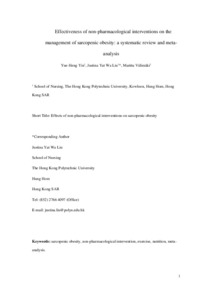| dc.description.abstract | Background: Sarcopenic obesity is a combination of both sarcopenia and obesity, which potentiate each other and maximize the negative influences of each, such as physical disability, morbidity, or even mortality. Objectives: To describe the criteria used to identify people with sarcopenic obesity and the components of the non-pharmacological interventions used to manage it, and to evaluate the effectiveness of those interventions.Methods: Randomized controlled trials (RCTs) in Cochrane Library, Scopus, EMBASE, PscyINFO, CINAHL and PubMed were searched. The risk of bias was examined using the Cochrane risk of bias tool. The template for intervention description and replication (TIDieR) checklist was used to summarize the intervention components. Meta-analyses were conducted using random-effect models to pool estimates of the effects of the non-pharmacological interventions on body composition, BMI, grip strength, and gait speed.Results: Sixteen papers (12 RCTs) with 863 participants were included. Diverse diagnostic criteria were used in the studies. Four categories of interventions were used: exercise (aerobic exercises, resistance exercises and exercise machines), nutritional interventions (supplements or dietary control), combined intervention and electrical acupuncture. Intervention durations varied from 8 to 28 weeks. Meta-analyses revealed that exercise with or without nutritional interventions had significant effects on grip strength (exercise: mean difference (MD): 1.63 kg, 95% confidence interval (CI): 0.94, 2.32, P < 0.00001; exercise + nutrition: MD: 1.24 kg, 95% CI: 0.48, 1.99, P = 0.001) and gait speed (exercise: MD: 0.13 m/s, 95% CI: 0.08, 0.18, P < 0.00001, I-2 = 0%; exercise + nutrition: MD: 0.04 m/s, 95% CI: 0.02, 0.06, P = 0.0002). Exercise had significant effects on reducing the percentage of body fat (PBF) compared to usual care (MD: -1.08%, 95% CI: -1.99, -0.17, P = 0.02), while exercise combined with nutritional interventions showed no superiority over exercise solely on decreasing PBF (P = 0.49). Exercise combined with nutritional interventions had significant effects on increasing appendicular skeletal muscle mass (MD: 0.43 kg, 95% CI: 0.20, 0.66, P = 0.0003). Low-caloric high-protein diets showed no superiority over low-caloric low-protein diets in increasing fat-free mass. Subgroup analyses showed that using different formulas to estimate the skeletal muscle mass index may lead to significant differences in determining the effects of exercise on grip strength.Conclusion: The diagnostic criteria for sarcopenic obesity used in future studies should refer to the latest consensus definition. Exercise tended to be the most effective method of improving grip strength and physical performance (e.g. gait speed). The combined effects of exercise and nutritional interventions on muscle mass and muscle strength require further exploration. | |
